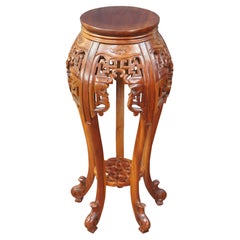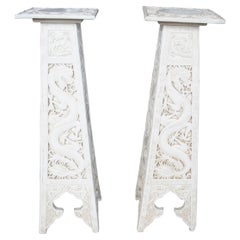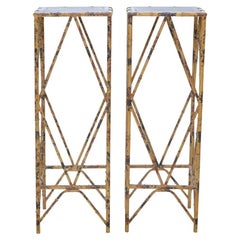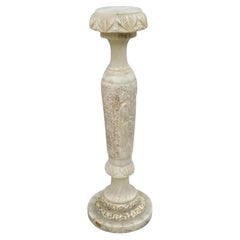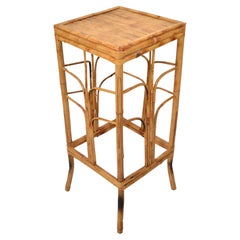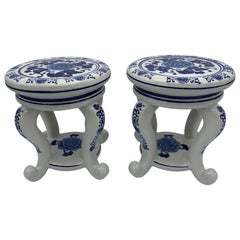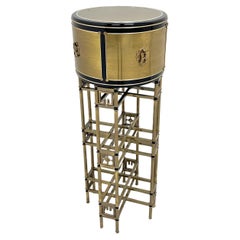Chinoiserie Plant Pedestal
Late 20th Century Chinoiserie Pedestals
Mahogany
Vintage 1980s American Chinoiserie Pedestals
Plaster
Early 20th Century Unknown Chinoiserie Pedestals
Metal
Mid-20th Century Unknown Chinoiserie End Tables
Marble
Early 20th Century Unknown Chinoiserie Tables
Alabaster
Late 20th Century Philippine Chinese Chippendale Tables
Bamboo, Cane
Recent Sales
20th Century Chinoiserie Pedestals and Columns
Ceramic
Late 20th Century Asian Chinoiserie Pedestals and Columns
Metal, Brass
Vintage 1970s American Chinoiserie Pedestals
Wood, Lacquer
Vintage 1960s Chinese Chinoiserie Pedestals
Marble
20th Century Southeast Asian Chinoiserie Pedestals
Stone, Marble
Antique 19th Century Chinese Chinoiserie Pedestals
Marble
Antique 19th Century Chinese Chinoiserie Pedestals
Marble
Early 20th Century Chinoiserie Pedestals and Columns
Ebony
Mid-20th Century Chinoiserie Pedestals and Columns
Rosewood
Vintage 1960s Chinoiserie Pedestals and Columns
Ceramic
Late 20th Century Unknown Chinoiserie Pedestals and Columns
Ceramic, Paint
Early 2000s Chinoiserie Pedestals and Columns
Faux Bamboo
Mid-20th Century North American Chinoiserie Side Tables
Glass, Wood
Mid-20th Century Asian Chinoiserie Pedestals
Bamboo, Wicker
Mid-20th Century Asian Chinoiserie Pedestals
Bamboo, Wicker
Late 20th Century American Chinoiserie Pedestals
Bamboo, Wicker
Antique 19th Century Chinese Chinoiserie Pedestals
Marble
Antique 19th Century Chinese Chinoiserie Pedestals
Marble
Vintage 1970s Chinoiserie Pedestals and Columns
Bamboo
Vintage 1970s Asian Chinoiserie Pedestals and Columns
Bamboo
Mid-20th Century Asian Chinoiserie Pedestals and Columns
Ceramic
People Also Browsed
Mid-20th Century French Neoclassical Benches
Bronze, Wrought Iron
21st Century and Contemporary Chinese Wallpaper
Silk
Vintage 1970s American Chinese Chippendale Benches
Wood, Faux Bamboo
21st Century and Contemporary Vietnamese Empire Center Tables
Wood
Antique 19th Century English Chinese Chippendale Vitrines
Glass, Mahogany
Antique Mid-19th Century English High Victorian Taxidermy
Other
21st Century and Contemporary American Neoclassical Patio and Garden Fur...
Granite, Iron
Antique Mid-19th Century Chinese Chinoiserie Paintings
Paper
20th Century American Chinoiserie Metalwork
Metal
20th Century American Chinoiserie Wall Mirrors
Brass
Mid-20th Century Chinoiserie Decorative Boxes
Lacquer
Early 20th Century English Charles II Settees
Tapestry, Velvet
20th Century Chinese Chinese Export Furniture
Marble
21st Century and Contemporary Philippine American Colonial Side Tables
Bamboo, Rattan
Vintage 1940s American Dining Room Chairs
Giltwood, Lacquer, Wood
21st Century and Contemporary American Pillows and Throws
Leather, Velvet
Chinoiserie Plant Pedestal For Sale on 1stDibs
How Much is a Chinoiserie Plant Pedestal?
A Close Look at Chinoiserie Furniture
Emerging in the 17th century, chinoiserie appropriated the aesthetics and imagery of popular East Asian design for European-made versions. Reflecting the exoticization of China, Japan and other countries in this era, the word directly translates from French to “Chinese-esque,” which reveals its shortcomings as a style of furniture and decor that often stereotypically and reductively mimics Asian culture rather than showcasing and paying tribute to its artistic traditions.
The enthusiastically decorative chinoiserie style was propelled by influential tastemakers including French King Louis XIV, whose Trianon de Porcelaine in 1670 was inspired by Chinese architecture. Expanded trade between the East and West led to a demand for porcelain, lacquer objects, silk and other goods, which further informed the fanciful furniture being crafted in Europe.
Artisans working in the chinoiserie style used materials and elements like pagoda shapes, bamboo, lacquer surfaces, bird and flower motifs and other interpretations of Asian design on pieces that were frequently set against vibrant wallcoverings. This whimsical approach yielded chinoiserie furniture that boasted dramatic flourishes drawing on the natural world and reflected the dominance of Rococo during the 18th century.
As chinoiserie was shaped by approximations of Asian design by European creators, it had regional variations, such as Chinese Chippendale in England where cabinets, chairs and tea tables had wooden fretwork designs and “japanned” surfaces intended to resemble lacquer work that was created in East Asia. In North America, furniture makers in Boston and New York integrated chinoiserie-painted scenes into Queen Anne furniture.
Antique chinoiserie furniture has continued to be fashionable, from its popularity with decorators of the Hollywood Regency era — James Mont, Tommi Parzinger, William Haines and Samuel Marx favored the style — to contemporary interior designers, although it brings with it a complex history.
Find a collection of chinoiserie bedroom furniture, cabinets, decorative objects and more on 1stDibs.
- How do I make a plant pedestal?1 Answer1stDibs ExpertApril 5, 2022A plant pedestal can be fashioned from a variety of materials or objects, from upturned buckets and baskets, to shelves and hand-crafted stands. On 1stDibs, find a variety of plant pedestals from top sellers around the world.
